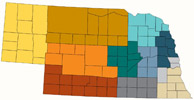Extension, Cooperative

Nebraska Cooperative Extension: Faculty and Staff Publications
Assessing Nitrogen Management in Corn for Nitrous Oxide Emissions: How Field to Market Is Approaching the Challenge.
Document Type
Article
Date of this Version
2018
Loading...
Citation
Johnson, L. J., T. McClellan Maaz, C. A. Shapiro, L. B. Moody, and C. S. Snyder. 2018. Assessing Nitrogen Management in Corn for Nitrous Oxide Emissions: How Field to Market Is Approaching the Challenge. In Proceedings of 2018 ASA and SCCA Meeting. November 4-7, 2018. Baltimore, MD. https://scisoc.confex.com/scisoc/2018am/meetingapp.cgi/Paper/111584
Presented Wednesday, November 7, 2018, 08:25 AM - 08:40 AM ; Baltimore Convention Center, Room 330
Abstract
Field to Market utilizes the Fieldprint® Platform to give farmers a quantitative assessment of eight environmental metrics (https://fieldtomarket.org/ ). One of these metrics calculates greenhouse gas emissions, including nitrous oxide (N2O). The present version of the metric determines N2O based on a factor related to the applied nitrogen rate. However, corn (Zea mays) research around the United States indicates that estimates for N2O emissions could be refined by considering the land resource region, soil type, and certain management practices that reduce N2O emissions. In 2015 the Fertilizer Institute and the International Plant Nutrition Institute led an effort to gather N2O and nitrogen management experts together to determine the best management practices for reducing N2O emissions. The group developed five tables for corn production in specific geographical regions in the United States and reached a consensus that reductions of 7 and 14 percent from the base emission rate could be achieved through intermediate and advanced practices, respectively, identified within each table. Fieldprint® Platform version 3, scheduled for release in late 2018, will include these revisions. This presentation will discuss how logic was developed to determine the level of advancement in management level for each unique production system. To do this, consensus from the original team leaders was needed to bring consistency in language between the tables and move from a general idea to a specific, quantifiable parameter that allows for a decision.

